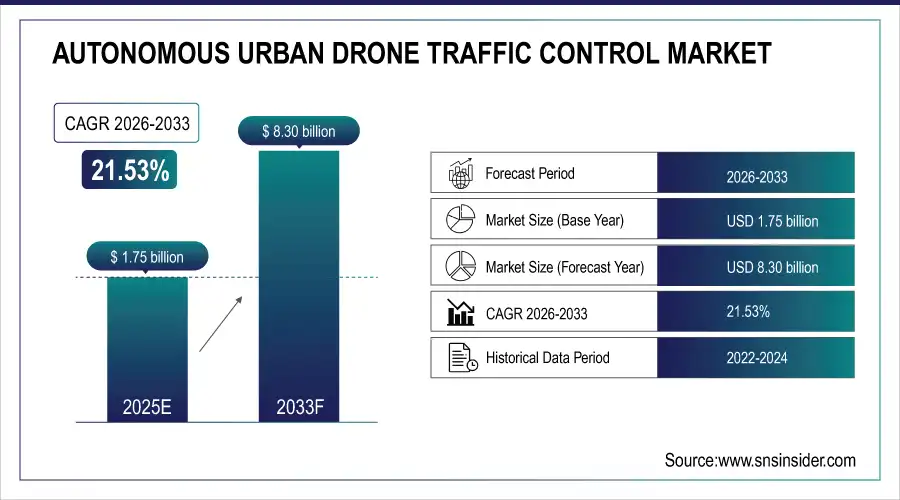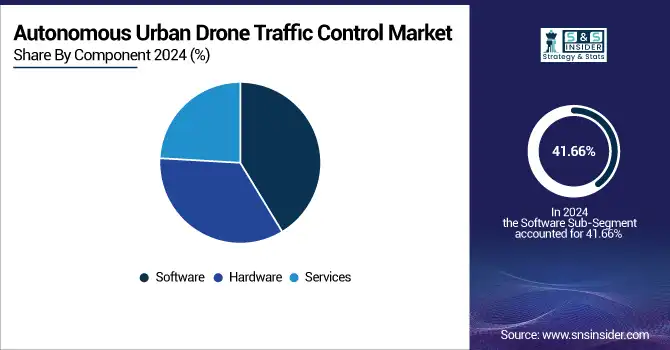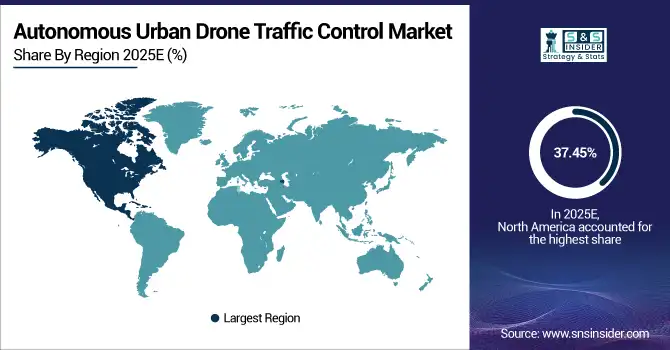Autonomous Urban Drone Traffic Control Market Report Scope & Overview:
The Autonomous Urban Drone Traffic Control Market size was valued at USD 1.75 Billion in 2025E and is projected to reach USD 8.30 Billion by 2033, growing at a CAGR of 21.53% during 2026-2033.
Autonomous Urban Drone Traffic Control market is about managing and regulating urban airspace for safe, and efficient operations of drones. With existing hardware, software, and services, it allows navigation, collision avoidance, traffic management, and surveillance in real-time. With the new growth areas of urban air mobility, delivery services, and other regulations, the market is expanding rapidly and has seen strong adoption mainly in North America and Asia-Pacific.

To Get more information on Autonomous Urban Drone Traffic Control Market - Request Free Sample Report
Researchers at Eötvös Loránd University developed a swarm of 100 autonomous drones capable of real-time collision avoidance and trajectory planning without centralized control. Inspired by the collective behavior of animals, these drones can communicate and coordinate with each other independently
Key Autonomous Urban Drone Traffic Control Market Trends
-
Increasing adoption of Unmanned Traffic Management (UTM) systems to enable safe, coordinated urban drone operations.
-
Growing demand for AI-driven traffic orchestration and real-time collision avoidance in drone navigation.
-
Expansion of passenger drone services and urban air taxis as part of urban air mobility initiatives.
-
Integration of AI, IoT, and 5G technologies for scalable, real-time drone traffic control.
-
Rising focus on smart-city projects, infrastructure monitoring, and emergency response applications using drones.
The U.S. Autonomous Urban Drone Traffic Control Market size was valued at USD 0.49 Billion in 2025E and is projected to reach USD 2.24 Billion by 2033, growing at a CAGR of 5.42% during 2026-2033. Some of the driving forces of growth in the U.S. Autonomous Urban Drone Traffic Control market include increasing adoption of urban air mobility (UAM), drone delivery of advanced services, regulations by FAA in support of UAM services, and investments in the UTM systems. Rapid growth of the market due to increased demand for efficient airspace coordination and safety and real-time traffic monitoring.

Autonomous Urban Drone Traffic Control Market Growth Drivers:
-
Rapid Advancements in Urban Air Mobility and Drone Technology Drive Global Autonomous Urban Drone Traffic Control Market Growth
The global Autonomous Urban Drone Traffic Control market is driven by rapid advancements in urban air mobility (UAM) and drone technology. Increasing demand for efficient, safe, and coordinated drone operations in urban areas is fueling the adoption of Unmanned Traffic Management (UTM) systems. Key drivers include the growth of e-commerce and last-mile delivery services, which rely heavily on autonomous drones, and expanding government initiatives to integrate drones into national airspace. Technological innovations such as AI-driven traffic orchestration, real-time collision avoidance, and advanced communication systems are also boosting market growth. Additionally, rising investments from public and private sectors, coupled with supportive regulations in key markets such as North America, Europe, and Asia-Pacific, are accelerating deployment of drone traffic control infrastructure.
In the U.S., the 2024 FAA Reauthorization Act includes provisions for drone inspections, education, and infrastructure inspection programs, highlighting a commitment to integrating drones into the national airspace system
Autonomous Urban Drone Traffic Control Market Restraints:
-
Regulatory Complexity Privacy Concerns and Technical Challenges Restrain Autonomous Urban Drone Traffic Control Market Growth
Airspace laws differ widely across countries, which can present challenges for the growth of the Autonomous Urban Drone Traffic Control market, thereby impeding large-scale adoption. The deployment, particularly in emerging economies is limited due to advanced hardware, software integration, and infrastructure development costs. Public acceptance of surveillance and data management is hampered by privacy and security concerns. Growth is also constrained by data processing, communication reliability and interoperability technical challenges. There are similarly risks of system failures or cyber-attacks that threaten safety and security meaning, that any systems that require widespread implementation needs to be held to a very high standard in terms of safety as well others to ensure that cyber-security is also risk-free.
Autonomous Urban Drone Traffic Control Market Opportunities:
-
AI IoT and 5G Integration Unlocks Significant Growth Opportunities in Autonomous Urban Drone Traffic Control
The market opportunity lies in the integration of AI, IoT, and 5G technologies to enable scalable, real-time traffic management for autonomous drones. Expansion of passenger drone services and urban air taxis offers significant growth potential, particularly in densely populated cities. Emerging economies with high urbanization rates are exploring drone-based delivery and emergency response solutions, creating untapped opportunities. Furthermore, the demand for smart-city initiatives, infrastructure monitoring, and disaster management applications is expected to expand the scope of drone traffic control systems globally.
Australia is developing a sophisticated air traffic control system to manage the anticipated influx of drones and flying taxis over the next decade, with projections indicating drone flights will increase from 1.5 million annually to 60 million by 2043
Autonomous Urban Drone Traffic Control Market Segment Analysis
-
By Component, Software dominated with 41.66% in 2025E, and it is expected to grow at the fastest CAGR of 21.92% from 2026 to 2033.
-
By System, Traffic Management System dominated with 34.67% in 2025E, while Collision Avoidance System is expected to grow at the fastest CAGR of 22.66% from 2026 to 2033.
-
By Application, Delivery & Logistics dominated with 38.41% in 2025E, while Air Taxis & Passenger Drones is expected to grow at the fastest CAGR of 22.62% from 2026 to 2033.
-
By End User, Transportation & Logistics Providers dominated with 37.32% in 2025E, and it is expected to grow at the fastest CAGR of 22.15% from 2026 to 2033.
By Component, Software Segment Leads Autonomous Urban Drone Traffic Control Market with AI and IoT Driving Future Growth
In 2025E, the Software segment dominates the Autonomous Urban Drone Traffic Control market due to its critical role in enabling real-time traffic management, AI-driven navigation, collision avoidance, and data analytics. With increasing adoption of urban air mobility and drone delivery services, demand for advanced software solutions will surge. From 2026–2033, software is expected to grow at the fastest CAGR, driven by innovations in AI, cloud computing, IoT integration, and scalable Unmanned Traffic Management (UTM) platforms.

By System, Radar Traffic Management Systems Dominate Autonomous Urban Drone Traffic Control Market with Collision Avoidance Driving Future Growth
In 2025, the Traffic Management System segment dominates the Autonomous Urban Drone Traffic Control market, as it is essential for coordinating safe, efficient drone operations in urban airspace. This dominance is driven by growing urban air mobility initiatives, regulatory frameworks, and demand for real-time airspace orchestration. From 2026–2033, the Collision Avoidance System segment is expected to grow at the fastest CAGR, propelled by advancements in AI, sensor technologies, and safety regulations requiring autonomous obstacle detection and avoidance capabilities.
By Application, Delivery and Logistics Segment Leads Autonomous Urban Drone Traffic Control Market with Air Taxis Driving Future Growth
In 2025, the Delivery & Logistics segment dominates the Autonomous Urban Drone Traffic Control market, driven by the rapid expansion of e-commerce, last-mile delivery, and healthcare supply transport using drones. This dominance is supported by strong demand for efficient, contactless delivery solutions. From 2026–2033, the Air Taxis & Passenger Drones segment is expected to grow at the fastest CAGR, fueled by advancements in urban air mobility, regulatory approvals, and investments in passenger drone infrastructure and autonomous traffic control systems.
By End User, Transportation and Logistics Providers Lead Autonomous Urban Drone Traffic Control Market with Rapid Future Growth
In 2025E, Transportation & Logistics Providers dominate the Autonomous Urban Drone Traffic Control market, driven by widespread adoption of drone-based delivery solutions, growing e-commerce demand, and the need for efficient airspace coordination. This segment benefits from integrating Unmanned Traffic Management (UTM) systems to optimize fleet operations and reduce delivery times. From 2026–2033, it is expected to grow at the fastest rate, fueled by continuous advancements in drone technology, AI-powered traffic control, and expansion of urban air mobility networks worldwide.
Autonomous Urban Drone Traffic Control Market Report Analysis
North America Autonomous Urban Drone Traffic Control Market Insights
In 2025E, North America dominates the Autonomous Urban Drone Traffic Control market with an estimated 37.45% share, driven by strong technological infrastructure, advanced drone regulations, and early adoption of urban air mobility solutions. The region benefits from significant investments by government and private sectors, extensive R&D activities, and established Unmanned Traffic Management (UTM) frameworks supporting safe and efficient drone operations.

Get Customized Report as per Your Business Requirement - Enquiry Now
U.S. America Autonomous Urban Drone Traffic Control Market Insights
The U.S. Autonomous Urban Drone Traffic Control market is advancing rapidly, driven by FAA-supported regulations, growing urban air mobility projects, drone delivery expansion, and technological innovations in AI, communication, and collision avoidance systems for safe, efficient airspace management.
Asia Pacific Autonomous Urban Drone Traffic Control Market Insights
The Asia Pacific region is expected to grow at the fastest CAGR of 22.74% from 2026–2033 in the Autonomous Urban Drone Traffic Control market. This growth is driven by rapid urbanization, increasing adoption of urban air mobility, and strong investments in Unmanned Traffic Management (UTM) infrastructure. Technological advancements, supportive regulatory frameworks, and rising demand for drone-based delivery, emergency response, and surveillance solutions are accelerating market expansion throughout the region during this period.
China Autonomous Urban Drone Traffic Control Market Insights
The China Autonomous Urban Drone Traffic Control market is expanding rapidly, driven by strong government support, advanced drone technology adoption, extensive urban air mobility initiatives, and investments in Unmanned Traffic Management systems for safe, efficient, and large-scale drone operations.
Europe Autonomous Urban Drone Traffic Control Market Insights
In 2025, Europe is projected to hold a 21.65% share of the Autonomous Urban Drone Traffic Control market. Growth is supported by strong regulatory frameworks, significant investments in Unmanned Traffic Management (UTM) systems, and increasing adoption of urban air mobility solutions. Technological advancements, government initiatives, and collaborations between public and private sectors are driving efficient drone traffic management and safe integration into urban airspace across the region.
Germany Autonomous Urban Drone Traffic Control Market Insights
The Germany Autonomous Urban Drone Traffic Control market is growing steadily, driven by strong regulatory frameworks, advanced drone technology adoption, and substantial investments in Unmanned Traffic Management systems. Government initiatives and smart-city projects are accelerating safe integration of drones into urban airspace for delivery, surveillance, and mobility services.
Latin America (LATAM) and Middle East & Africa (MEA) Autonomous Urban Drone Traffic Control Market Insights
The Latin America (LATAM) and Middle East & Africa (MEA) Autonomous Urban Drone Traffic Control market is emerging steadily, driven by growing interest in smart-city projects, urban air mobility, and drone-based delivery services. Increasing investments in Unmanned Traffic Management systems, government support, and infrastructure development are enabling safer, more efficient drone operations, while regulatory advancements are fostering innovation and adoption in these regions.
Competitive Landscape for Autonomous Urban Drone Traffic Control Market:
Thales Group is a global leader in aerospace, defense, and security solutions, offering advanced Autonomous Urban Drone Traffic Control systems through its Unmanned Traffic Management (UTM) platforms like TopSky‑UTM and AstraUTM. The company enables safe, scalable drone operations with real-time traffic management, collision avoidance, and regulatory compliance for urban air mobility.
- In July 2024, Thales has partnered with Garuda Aerospace to enhance secure drone operations in India. The Memorandum of Understanding (MoU), effective from August 2024, aims to transform the Indian drone landscape by integrating advanced UTM solutions and promoting safe and efficient drone operations across the country.
Raytheon Technologies is a prominent player in the Autonomous Urban Drone Traffic Control market, offering advanced solutions to integrate unmanned aerial systems (UAS) into national and global airspace. Their Integrated Tactical Airspace Management and Monitoring System (ITAAMS) provides real-time airspace management, supporting both manned and unmanned aircraft operations
- In April 2025, Raytheon signed a term sheet with the United Arab Emirates' Tawazun Council to produce the Coyote counter-uncrewed aircraft system (C-UAS) interceptor in the UAE. This move aims to strengthen defense ties between the US and UAE and boost readiness and supply chain resilience.
Autonomous Urban Drone Traffic Control Market Key Players:
Some of the Autonomous Urban Drone Traffic Control Market Companies
- Thales Group
- Raytheon Technologies
- Unifly
- DJI Technologies
- Airbus SE / Airbus UTM
- Boeing NeXt
- ANRA Technologies
- Altitude Angel
- OneSky Systems
- Lockheed Martin Corporation
- Volocopter GmbH
- Amazon Prime Air
- SkyGrid
- Matternet
- Lilium GmbH
- Wing (Alphabet)
- Flytrex
- Terra Drone Corporation
- AirMap Inc.
- Frequentis AG.
| Report Attributes | Details |
|---|---|
| Market Size in 2025E | USD 1.75 Billion |
| Market Size by 2033 | USD 8.30 Billion |
| CAGR | CAGR of 21.53% From 2026 to 2033 |
| Base Year | 2025E |
| Forecast Period | 2026-2033 |
| Historical Data | 2022-2024 |
| Report Scope & Coverage | Market Size, Segments Analysis, Competitive Landscape, Regional Analysis, DROC & SWOT Analysis, Forecast Outlook |
| Key Segments | • By Component (Hardware, Software, and Services) • By System (Communication & Navigation System, Collision Avoidance System, Traffic Management System, and Surveillance & Monitoring System) • By Application (Air Taxis & Passenger Drones, Delivery & Logistics, Emergency Response & Healthcare, and Infrastructure Inspection & Surveillance) • By End User (Government & Public Safety Agencies, Transportation & Logistics Providers, Healthcare Institutions, and Infrastructure & Utility Companies) |
| Regional Analysis/Coverage | North America (US, Canada), Europe (Germany, UK, France, Italy, Spain, Russia, Poland, Rest of Europe), Asia Pacific (China, India, Japan, South Korea, Australia, ASEAN Countries, Rest of Asia Pacific), Middle East & Africa (UAE, Saudi Arabia, Qatar, South Africa, Rest of Middle East & Africa), Latin America (Brazil, Argentina, Mexico, Colombia, Rest of Latin America). |
| Company Profiles | Thales Group, Raytheon Technologies Corporation, Unifly, DJI Technologies, Airbus SE, Boeing NeXt, ANRA Technologies, Altitude Angel, OneSky Systems, Lockheed Martin Corporation, Volocopter GmbH, Amazon Prime Air, SkyGrid, Matternet, Lilium GmbH, Wing (Alphabet), Flytrex, Terra Drone Corporation, AirMap Inc., Frequentis AG. |

